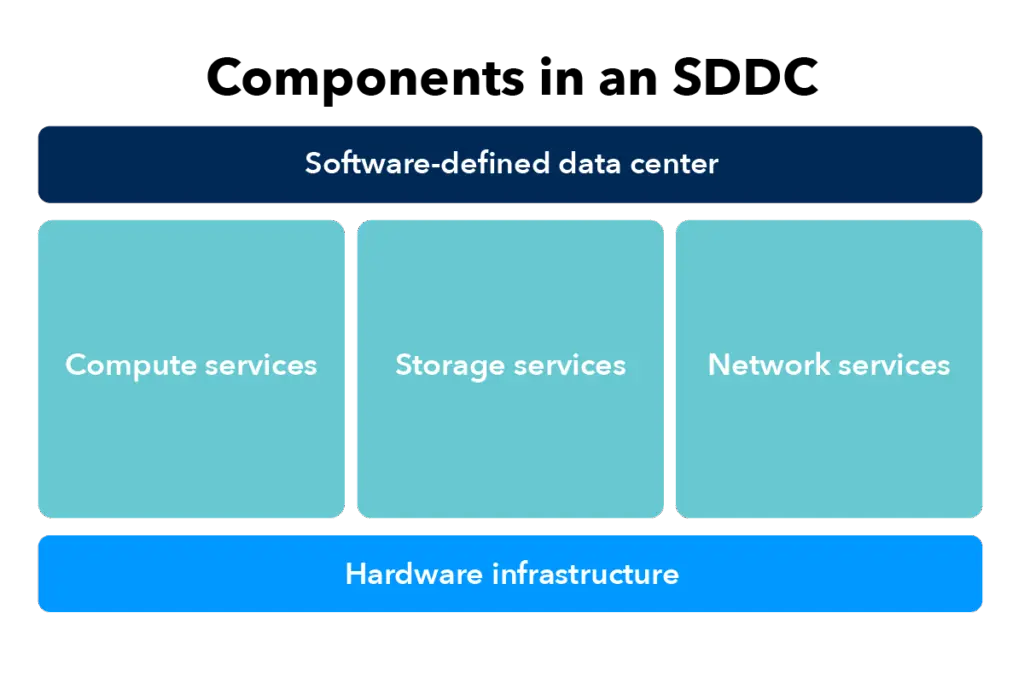The evolution of enterprise infrastructure
Enterprise infrastructure is accelerating toward a future where software-defined capabilities redefine agility, scalability, and efficiency. A next-gen Software-Defined Data Center (SDDC) represents the culmination of this transformation, integrating automation, virtualization, and cloud-native technologies to create a fully orchestrated and intelligent infrastructure ecosystem. Originally coined in 2012 by VMware, this concept has grown into a fully realized strategy over the past 13 years.
Organizations embracing this shift can unlock unprecedented operational efficiency, cost savings, and innovation while enhancing resilience and security.
This post will explore the benefits of an SDDC and compare it to other standard enterprise compute models.
Decoupling hardware for maximum flexibility
At the core of a Software-Defined Data Center is the decoupling of hardware dependencies, enabling a software-driven infrastructure that dynamically adjusts to workload demands. This virtualization abstracts compute, storage, and networking into software-defined components. SDDC allows enterprises unparalleled flexibility, reducing reliance on traditional, static environments.

A unified management and command center further enhances this model by providing a single-pane-of-glass view into the entire infrastructure. AI-driven insights, predictive analytics, and automated provisioning streamline operations, ensuring that IT teams can focus on strategic initiatives rather than routine maintenance. Organizations that implement AI-driven infrastructure management can reduce downtime and improve system performance.
Also read: Next-Gen Networking: The Benefits of SASE in a Heightened Threat Landscape
Virtual Private Cloud and multi-tenancy
One of the most transformative aspects of an SDDC is the ability to deliver Virtual Private Cloud (VPC) environments as a competitive offering. This capability allows organizations to provide logically isolated, highly secure, scalable cloud instances tailored to specific business needs.
Multi-tenancy optimizes resource utilization, enabling multiple customers or departments to share infrastructure without compromising performance or security. Cost efficiency is a critical driver in this evolution, and SDDC architectures leverage automation and AI-driven workload placement to reduce operational expenditures while enhancing performance.
By shifting from CAPEX-intensive infrastructure to an OPEX-friendly consumption model, enterprises can reduce total infrastructure costs, improve budget flexibility, and enable scalable investments in digital transformation.
SDDC, traditional data centers, and cloud computing
An SDDC differs from a conventional data center because it virtualizes and abstracts physical hardware, enabling automated, policy-driven resource management. In contrast, conventional data centers depend on manually configuring and managing individual hardware components.
The Software-Defined Data Center emphasizes the foundational infrastructure and architecture that supports various computing environments. In contrast, cloud computing primarily concerns the services and functionalities it offers users. In other words, SDDC serves as the essential framework for building public cloud environments but can also be effectively utilized in private and hybrid cloud setups. This distinction highlights how SDDC can enhance data center operations while contributing to the broader cloud ecosystem.
| Feature / Aspect | Software-Defined Data Center | Traditional Data Center | Cloud Computing |
| Infrastructure Management | Virtualized and automated | Manual configuration and management | Managed by cloud service providers |
| Resource Allocation | Dynamic and policy-driven | Static and hardware-dependent | On-demand self-service |
| Scalability | Highly scalable, dynamic adjustments | Limited by physical hardware | Elastic scalability |
| Cost Model | OPEX focused | CAPEX intensive | OPEX (pay-as-you-go) |
| Flexibility | High, decouples hardware dependencies | Rigid, tied to on-prem hardware | Highly flexible, resources can be tailored |
| Security | Enhanced through isolation (e.g., VPC) | A physical perimeter defines security | Security models vary by provider |
| Deployment Speed | Rapid deployment with automation | Longer deployment times | Immediate access to resources |
| Management Tools | Unified management interface with AI | Separate tools for different hardware | Managed tools provided by the cloud service |
| Workload Management | AI-driven, automated workload placement | Manual workload distribution | Automated load balancing |
| Use of Containerization | Integral to Kubernetes and microservices | Not typically utilized | Often involves containerization |
| Ideal Use Cases | Modern applications, microservices | Legacy applications, older infrastructure | Diverse applications, scalable solutions |
The role of containerization and Kubernetes
The proliferation of containerization has further revolutionized how applications are developed and deployed within SDDCs. Kubernetes and microservices architectures provide a standardized, portable, and resilient environment for application delivery. This approach accelerates innovation, improves scalability, and enhances overall system reliability, making it an essential pillar of modern infrastructure strategies.
Organizations adopting containerized workloads experience faster application deployment times and can improve resource utilization.
AI-driven operations and predictive analytics
AI automation plays a pivotal role in optimizing infrastructure management. Organizations can proactively mitigate risks, reduce downtime, and enhance system resilience by leveraging machine learning algorithms for predictive maintenance, anomaly detection, and workload balancing.
AI-powered IT operations can minimize incident resolution times, leading to higher system availability and improved user experience.
Also read: How Pomeroy Is Using Generative AI to Enhance Customer Service and Improve Client Experience
A phased approach to SDDC implementation
As enterprises embark on their SDDC journey, they must adopt a phased approach to implementation to avoid disruptions and gain the most benefits from the virtualization strategy. These phases include:
- Initial phase: Assessing existing infrastructure, defining a software-defined architecture, and identifying automation opportunities.
- Transition phase: Moving to a virtualized environment with unified management tools and automation frameworks for operational efficiency.
- Final phase: Scaling automation, implementing predictive analytics, and establishing a Center of Excellence to sustain innovation and stay at the forefront of technology advancements.
The impact of a fully realized SDDC is profound. The shift from traditional infrastructure models to software-defined ecosystems fosters greater agility, resilience, and competitive advantage. For industries that require rapid scaling, such as financial services, healthcare, and retail, SDDCs provide the foundation for real-time data processing, enhanced security postures, and seamless customer experiences.
The art of the possible in SDDC is no longer a distant vision—it is an achievable reality. By embracing software-defined infrastructure, enterprises can reimagine their IT landscape, drive innovation, and position themselves for sustained growth in the cloud era. The future of data centers is here, and it is software-defined.
Explore how transitioning to a Software-Defined Data Center can transform your organization’s infrastructure and drive operational efficiency.
Contact us today to learn more about implementing next-gen solutions tailored to your business needs.




